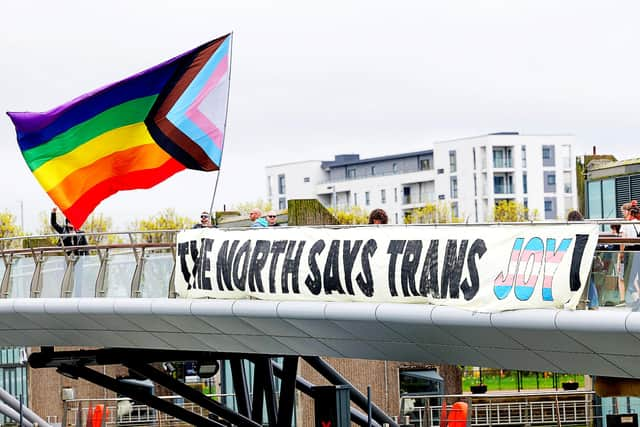School inspectors' report indicates 2% of pupils responding to survey identify as 'other' gender
and live on Freeview channel 276
The report is by a body called the Education and Training Inspectorate, and is largely based on polling and consultations with pupils on the subject of what it calls "the preventative curriculum".
This, in the inspectorate's own words, refers to lessons which help pupils "stay safe and develop healthy relationships, beliefs, and attitudes".
Advertisement
Hide AdAdvertisement
Hide AdOne graphic in the report is labelled: "Pupils who identify as 'other' in terms of gender (220, 2%)".


It is not very clear, though, how the report’s anonymous authors have arrived at that 2% figure (for example, it doesn't say what the question was which pupils were actually asked, nor does it say how many responses came from primary pupils, and how many from post-primary ones).
Given that there are some 150,000 pupils in Northern Ireland's post-primary schools alone, 2% of that figure would equate to 3,000 pupils now identifying as "other" if it were extrapolated out.
Such pupils "are much less likely to report that they feel safe in school," the report says, adding: "These pupils are also more than twice as likely to report that they don’t know how to manage or talk about their feelings, or deal with peer pressure.
Advertisement
Hide AdAdvertisement
Hide Ad"School/centre leaders will need to give more thought to the culture of inclusion across their organisation and keep it under review."
• ‘MORE GENDER IDENTITY EDUCATION’ •
The report also found: "Too many schools/centres avoid completely, or cover with insufficient depth and progression, many of the more sensitive aspects of the relationship and sex education aspect of the preventative curriculum."
This includes "teaching on gender and sexual identity [and] LGBTQ+".
"A common theme emerging from the pupils’ written comments and in discussions is their frustration at not being consulted sufficiently on the content, relevance, and delivery of the preventative curriculum…
Advertisement
Hide AdAdvertisement
Hide Ad"Schools/centres need to significantly increase the level of pupil participation and engagement to inform the content, delivery and impact of the preventative curriculum and to determine the extent to which the culture of the school/centre ensures inclusion and respect for all."
It also says that “it is clear from the questionnaire responses that pupils want impartial information and education on these sensitive areas which is integrated and reinforced throughout the curriculum”.
The report was published last week, and came to light thanks to BBC NI, which today reported on it under the headline: “Sexual consent teaching in NI schools 'not good enough'”.
• ‘I AM A QUEER CHILD’ •
The report is scattered throughout with selected quotes from schoolkids. Among those from post-primary pupils were these:
Advertisement
Hide AdAdvertisement
Hide Ad“Class debates about the morality of homosexuality, other religions, or non-cisgender identity are not appropriate. No-one should have to sit in a classroom and have their identity berated.”
“Teach different types of sex education as it wasn’t taught correctly and only for heterosexuals. It was also shamed upon very heavily by teachers.”
“Most of the topics we cover aren’t particularly ‘empowering’, they are quite useful for the future, but not empowering.”
“I don’t like being at school because every time I hear my dead name called (name before transition) it is excruciating. However, I will never ask for this to change for fear of safety at home and at school. Trans issues are not taught about in school and I think this is important to be taught…”
Advertisement
Hide AdAdvertisement
Hide Ad“I personally don’t believe our school is inclusive to personal developments that don’t fit their ideologies, sexuality education has never been discussed other than in religious studies where it has been shunned and left for a debate rather than show support and safety for those students.”
And among the quotes it attributes to primary school children are the following:
“I would like to talk about feeling welcome in communities such as being part of the LGBTQ+ community and accepting people in the LGBTQ+ community as well as being taught that we are welcome.”
“LGBTQ+ to show that it’s ok liking girls or guys or anyone and different sexualities people have. Because being a queer child myself, it’s not pleasant when people make fun of gay people.”
Advertisement
Hide AdAdvertisement
Hide AdThis morning the News Letter asked the Department of Education (which the inspectorate operates under) for clarity on the 2% figure, and for details on who leads the inspectorate and how they were appointed.
It had not responded at time of writing.
• MEASURING THE LGBTQQIA+ POPULATION •
Measuring the LGBTQQIA+ population is difficult, partly because of concerns that people may hide or misreport their sexuality.
The Office for National Statistics (ONS) has tackled the question a number of times, and in 2020 it reported that 1% of Northern Ireland's population aged 16+ were gay.
Another 0.4% were bisexual (and another 0.4% said 'other').
Meanwhile the results of the 2021 Census found that 2.1% of the region’s population identify as lesbian, gay, bisexual or other.
Advertisement
Hide AdAdvertisement
Hide AdIt particularly hard to gauge how many transgender people there are, not least because it is almost impossible to get an agreed definition of 'transgender'.
However the ONS reports that "less than five" of the 3,600 respondents to the Ulster University / QUB NI Life and Times Survey said they were transgender between 2016-18.
That would equate to somewhere between 0.1% and 0.02% of the population.